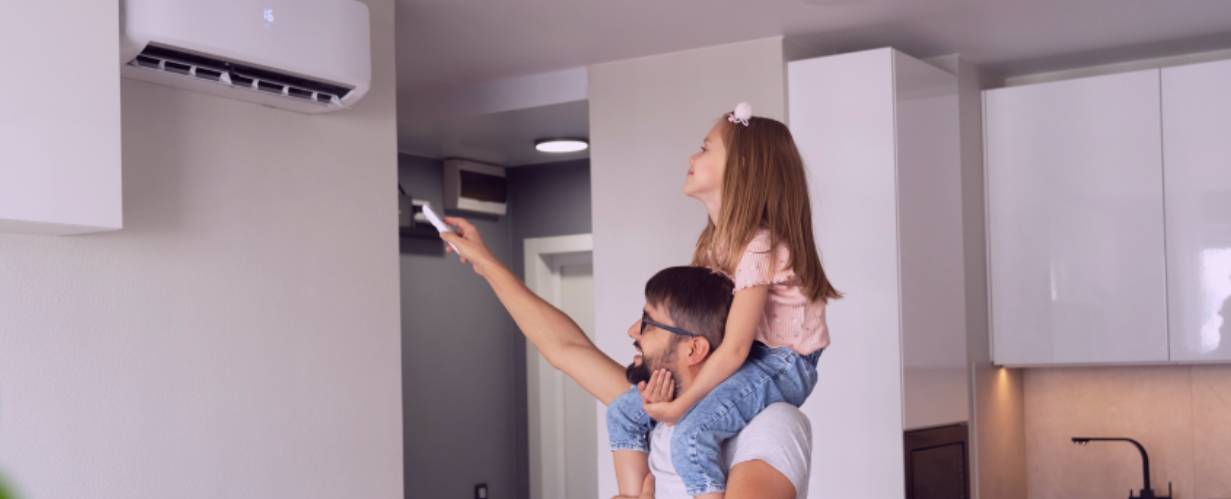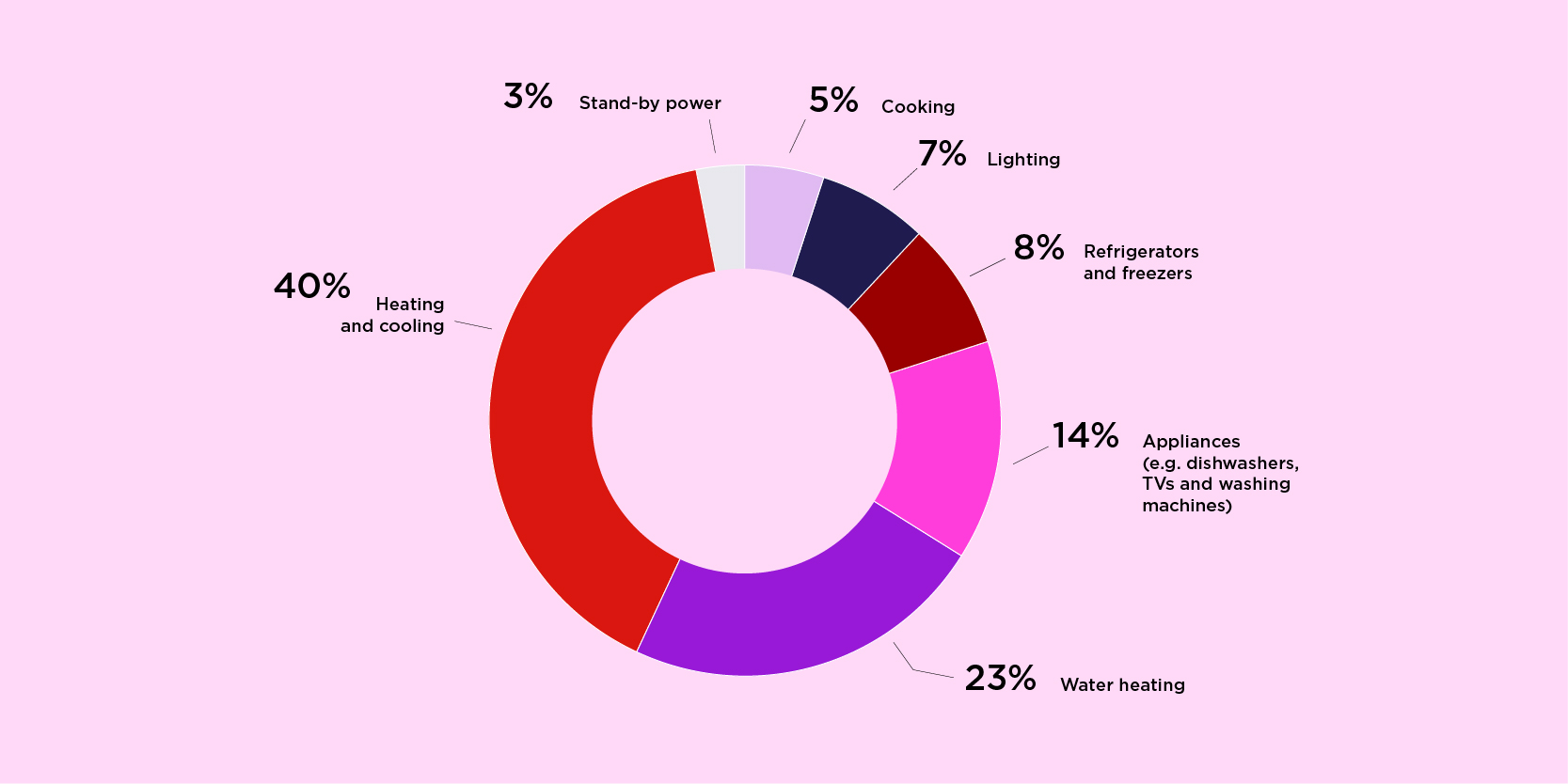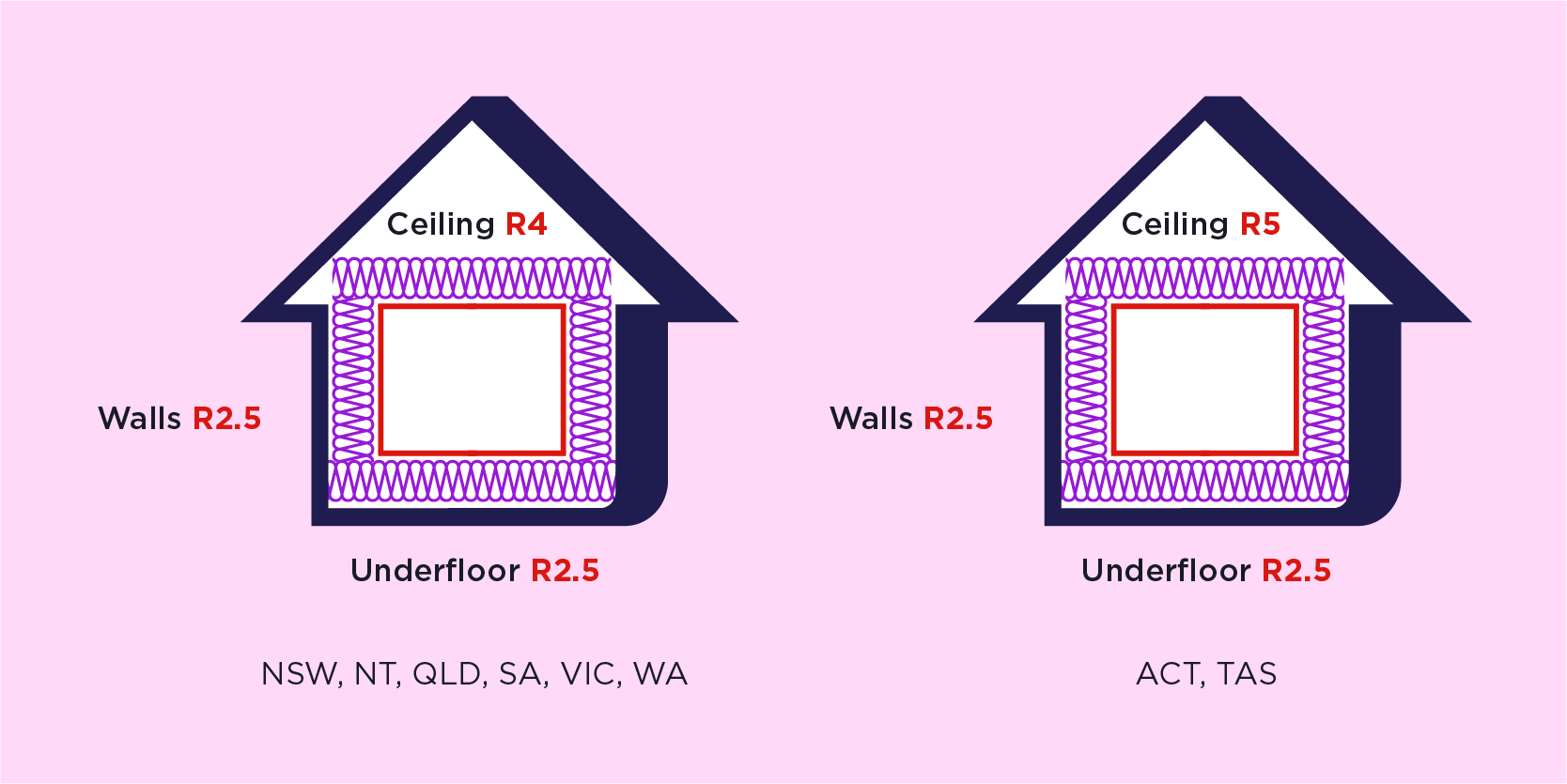Unlocking home energy savings
Saving energy is often considered crucial, not just to lower energy bills but also to help reduce greenhouse gas emissions. Most of the energy usage in homes goes to heating and cooling. The next big energy users are: water heaters, and high-energy usage appliances (such as fridges and TVs); followed by lighting; cooking; and devices left on standby mode.

Drawing inspiration from the Green Building Council of Australia’s Guide to Sustainable Home Renovations, this article explores sustainable home improvement ideas.
Any savings claims made in this article are general in nature and based on theoretical research findings. Actual costs and energy bill savings will depend on a range of factors including (but not limited to) location, property, system components, weather, energy consumption and feed-in tariffs.
What you'll learn
- The Potential Advantages of Sustainable Home Upgrades
- Why Upgrading Heating and Cooling Saves
- How Modern Hot Water Systems Help Cut Costs
- Selecting Energy-Efficient Appliances
- Why Electrification and Transitioning from Gas Supports a Sustainable Future
- How Solar Panels and Battery Storage Could Save Money and Make Your Home Energy Independent
- Incentives and Loans for Your Upgrades
- Unlocking Energy Savings
The Potential Advantages of Sustainable Home Upgrades
Making sustainable home upgrades and investing in energy-efficient appliances could lower your energy bills. Improvements such as better insulation, efficient windows, draught sealing, and transitioning from gas to electric appliances, may reduce the energy needed to keep your home comfortable, leading to potential savings over time. Using less energy may not only cut costs but also could help reduce the impact on the environment.
Energy-efficient home upgrades could benefit both your wallet and the world. With support from Westpac's Sustainable Upgrades home loan, now may be the time to consider investing in improvements towards a more energy-efficient and sustainable home. Visit Sustainable Upgrades home loan, to find out more.
Why Upgrading Heating and Cooling Saves
Insulation and how it works
Insulation slows heat flow, keeping homes warm in winter and cool in summer. Upgrading insulation in ceilings, walls, and under floors could reduce the energy needed for heating and cooling, lowering energy bills and emissions.
Types of Insulation and R-Values
- Insulation types include:
- Bulk Insulation: Traps air, providing resistance to heat flow.
- Reflective Insulation: Bounces heat away, reflecting radiant heat
- R-value: Measures the effectiveness of insulation. The higher the R-value, the better it insulates. Recommended minimum R-values for Australian homes are1:
- Walls and underfloor: R2.5
- Ceilings: R4 for NSW, NT, QLD, SA, VIC, WA
- Ceilings: R5 for ACT, TAS

Source: Green Building Council of Australia (GBCA). (2023). Sustainable Home Renovations Guide, Figure 4.
This chart shows how energy is used in Australian homes. In the chart, heating and cooling account for the most energy usage at 40%, followed by water heating at 23%. Appliances like dishwashers, TVs, and washing machines account for 14%. Refrigerators and freezers take up 8%, lighting uses 7%, cooking accounts for 5%, and devices left on standby contribute 3%.
Choosing Appropriate Insulation
When choosing insulation, it's important to think about both cost and quality. Determining a suitable level of insulation also relies on factors such as your climate, building construction, and the presence of heating or cooling systems. For example, reflective insulation typically works better for warmer climates whereas bulk insulation may be more appropriate for colder climates.
For more information on insulation, visit the YourHome Insulation Guide.
Energy-Efficient Windows: Tips
Windows consist of glazing and frames, both important for energy efficiency. Window glazing can be single, double, or even triple-pane, and frames can be made from different materials like wood, uPVC, or aluminium.
What are U-Values and Solar Heat Gain Coefficients?
U-value: measures how well a window prevents heat from escaping. The lower the U-value, the better it insulates. The Window Energy Rating Scheme explains how U-values for Australian products generally range from 2.0 to 10.0 W/m²K. Lower U-values (2.0-4.0) indicate better insulation, typical of double-glazed windows. Whereas higher U-values (6.1-10.0) indicate poorer insulation, typically found in single-glazed windows or older materials.
SHGC (Solar Heat Gain Coefficient): measures how much solar heat passes through the window. Lower values are typically better in hotter climates whereas higher values may be more suited to colder climates.
When choosing windows, consider the whole system (glazing and frame) U-value and Solar Heat Gain Coefficient, as well as the orientation and climate.
For more information on glazing, visit the YourHome Glazing Guide.
Choosing Energy-Efficient Windows
- Double-glazed windows, with two layers of glass and a gap in between, could reduce heat loss or gain.
- Wood and uPVC frames offer better insulation compared to aluminium frames, which transfer heat and cold easily.
- Low-emissivity (Low-E) glazing has a special coating which reduces heat transfer and could be used to improve both U value and SHGC.
Tips for Retrofitting Existing Windows
You might want to consider the following options:
- Adding secondary glazing to existing old windows to hold heat, and as a cheaper alternative to replacing them.
- Tinting to reduce heat intake, or low-E films to reflect heat away to improve energy efficiency for hotter climates.
- Heavy curtains or blinds to add insulation, and pelmets to reduce air movement behind the curtain.
- External blinds or shutters on east and west-facing windows to block direct sunlight and reduce heat gain, particularly in hotter climates.
Creating an Airtight Home
Creating an airtight home means reducing unwanted air leaks. By controlling air leakage, you could save on heating and cooling costs. However, it's important to balance an airtight home with adequate ventilation to prevent indoor air quality issues like condensation (leading to mould and damage) and pollutants (like dust, chemicals, and carbon dioxide).
Draught-Proofing Methods
Gaps at the bottom of doors and in between floorboards, leaks around windows, open vents, unused chimneys, or exhaust fans can let in a lot of air. To draught-proof them, you could use weatherstripping, install draught excluders at the bottom of doors, and check for and seal any gaps around doors and windows.
Balancing an Airtight Home with Ventilation
While it's important to reduce air leaks, a completely airtight home can trap moisture and contaminants, affecting indoor air quality. To balance airtightness and ventilation, you can use exhaust fans, regularly open windows, or consider using a Mechanical Ventilator with Heat Recovery (MVHR). A MVHR system continuously supplies filtered outside air, whilst removing stale air.
Heating & Cooling Systems
Switching to energy-efficient electric reverse cycle air conditioning, which heats and cools your home, could be beneficial. These systems are more energy efficient than other types of heating and cooling appliances, leading to cost savings, while also reducing greenhouse gas emissions2. For better energy efficiency, consider opting for an air conditioner with a high star rating. When purchasing a heating or cooling appliance, it’s important to select one that is appropriately sized for your needs.
Ceiling fans are often an inexpensive way to provide a cooling breeze. In addition, fans with a reverse function can help spread warm air in winter, making the room more comfortable.

This image illustrates the recommended minimum insulation R-values for different parts of a building. For ceilings, the recommended minimum R-value range is R4 for NSW, NT, QLD, SA, VIC, WA and R5 for ACT and TAS. For underfloors and walls, the recommended minimum R-value is R2.5.
How Modern Hot Water Systems Help Cut Costs
Old hot water heaters are often inefficient and costly. In contrast, modern systems such as hot water heat pumps and solar hot water systems are energy efficient and could be more cost-effective. Their efficiency is measured by the Coefficient of Performance (COP). A higher COP (ideally around 4.0) indicates greater energy efficiency which in turn could reduce your energy bill. Pairing these systems with water-efficient showerheads, which are designed to use less water while maintaining pressure, could further increase savings on utility bills.
Efficient hot water systems could reduce monthly energy usage, leading to potential savings on your energy bills. While the initial installation cost might seem high, the savings accumulated from reduced power consumption may offset these costs over the life of the system.
Selecting Energy-Efficient Appliances
Energy-efficient appliances typically use less electricity, saving money on energy bills and reducing environmental impact.
When selecting an appliance, consider the optimal size and power for your requirements, the operating cost relative to other models, and the most energy and water-efficient option.
Understanding Energy Ratings for Appliances
The stars on the Energy Rating Label go from one to ten (ten being the highest rating). Appliances with more stars might cost a bit more when you buy them, but they could save you money later because they use less electricity.
The Shift to Induction Cooking
Gas stoves heat up using flames that can lose a lot of energy in the air. Induction cooktops work differently — they make the pot itself warm up using a special magnetic field, which saves energy and cooks food faster.
Utilising the Energy Rating Calculator
The Australian Government provides a useful free tool to help you determine how much money you could save by choosing energy-efficient appliances. The Energy Rating Calculator compares the estimated running costs and energy efficiency of appliances, showing how much cheaper it could be to run a high-star appliance.
Why Electrification and Transitioning from Gas Supports a Sustainable Future
Transitioning from gas and electrifying your home is part of a larger shift towards clean energy sources like solar and wind power, reducing reliance on fossil fuels. Switching to energy-efficient electric appliances which use less energy to perform the same tasks as gas appliances, may result in lower energy bills.
According to a 2023 report by the Grattan Institute3, most households would save money by switching to all energy-efficient electric appliances. These savings are because electric appliances are typically more efficient than gas equivalents, resulting in lower running costs.
How Solar Panels and Battery Storage Could Save Money and Make Your Home Energy Independent
Understanding Solar Power and Battery Storage
Solar panels soak up sunlight and turn it into electricity you can use in your home. If you add batteries to your solar system, you can store the extra electricity for later use. This combination helps you rely less on the main power grid and can keep your lights on even during a power outage.
For more information on rooftop solar and batteries, check out the Australian Government's Solar Consumer Guide.
Investing in Solar
Solar panels could help you save on energy bills by generating your electricity instead of buying it from power companies. For more information on how solar may help lower energy bills, check out the Financial Benefits of Solar from the Australian Government’s Solar Consumer Guide.
Solar panels could also increase your home's value, as energy-efficient homes may attract buyers. According to the 2024 Sustainability in Property report from Domain, buyers are willing to pay more for homes with sustainable features. Government incentives and deals could also make investing in solar affordable.
Choosing Your Solar Setup
When choosing solar panels, consider both cost and quality; cheaper options may not last as long or work as effectively. You might want to get quotes from multiple companies, compare prices and offerings, check reviews, and ask about warranties. The New Energy Tech Website offers helpful tips and standards to support you making an informed and safer investment in solar technology.
Incentives and Loans for Your Upgrades
Various government incentives, rebates, and loans are available to support sustainable home upgrades. For detailed information on these financial aids, check the following resources:
Unlocking Energy Savings
By embracing energy-efficient home upgrades and purchasing energy-saving appliances, you could lower your energy bills. Renewable energy solutions, equipment upgrades, and insulation improvements could help homes use less energy and maintain a comfortable temperature. The Sustainable Upgrades home loan offered by Westpac, could help you to fund some of these energy-efficient home upgrades.
Find out more information from the Green Building Council of Australia's Guide to Sustainable Home Renovations.
1 Westpac’s Sustainable Upgrades home loan criteria.
2 YourHome. Heating and cooling. Accessed 29/07/2024.
3 Wood, T., Reeve, A., and Suckling, E. (2023). Getting off gas: why, how, and who should pay? Grattan Institute.
Things you should know
Conditions, credit criteria, fees and charges apply. Residential lending is not available for Non-Australian Resident borrowers.
This information is general in nature and has been prepared without taking your objectives, needs and overall financial situation into account. For this reason, you should consider the appropriateness of the information and if necessary, seek appropriate professional advice. This includes any tax consequences arising from any promotions for investors and customers should seek independent, professional tax advice on any taxation matters before making a decision based on this information.